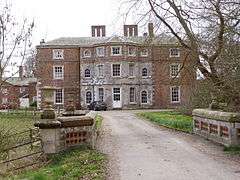Sir William Strickland, 4th Baronet
Sir William Strickland, 4th Baronet PC (c. 1686 – 1 September 1735), of Boynton, Yorkshire, was an English landowner and Whig politician, who sat in the House of Commons from 1708 to 1735. He was a Government Minister in Sir Robert Walpole's administration.

Strickland was the eldest son of Sir William Strickland of Boynton, a Yorkshire landowner and Member of Parliament, and his wife Elizabeth Palmes.[1]
At the 1708 British general election Strickland's father, who for some years had been MP for the local borough of Malton, was instead chosen as Member for Yorkshire – a much more prestigious constituency – and Strickland took his place representing Malton. From the first he was a loyal Whig and was recognised as a strong speaker.[2]
Strickland remained MP for Malton until 1715, then represented Carlisle from 1715 to 1722 and finally Scarborough for the remaining thirteen years of his life.[3]
Strickland inherited the baronetcy and Boynton Hall near Scarborough on his father's death in 1724.[1] He became a friend of Robert Walpole and held a succession of junior posts. He was a Lord of the Treasury from 1725 to 1727, and also became Treasurer of the Household to the Queen. In 1729 he chaired a Parliamentary Committee on reform of the legal profession. In 1730, when Walpole reconstructed his government and promoted Henry Pelham to be Paymaster-General, Strickland was chosen to take his place as Secretary at War (arguably the most important ministerial post outside the cabinet), and was made a Privy Counsellor. This post he held until forced to retire by ill health in May 1735.
Away from Parliament, Sir William spent a considerable sum on ambitious alterations to Boynton Hall, commissioning Lord Burlington to design a new frontage and William Kent to design the interiors. However, when he returned from London to view the work he found to his fury that the local builders had failed to follow Lord Burlington's instructions, and the rebuilt hall bore little resemblance to the plans, in particular having an "old-fashioned roof" instead of the fashionable Palladian style he had been expecting!
Srickland died on 1 September 1735 at Boynton. He had married Catherine Sambrooke, daughter of Sir Jeremy Sambrooke, by settlement dated 9 March 1723. They had one son – George, who succeeded him in the baronetcy – and one daughter. His wife outlived him by more than thirty years, dying on 9 February 1767.
References
- Cokayne, George Edward, ed. (1902), Complete Baronetage volume 2 (1625-1649), 2, Exeter: William Pollard and Co, retrieved 9 October 2018
- "STRICKLAND, William (c.1686-1735), of Boynton, Yorks". History of Parliament Online (1690-1715). Retrieved 18 July 2019.
- "STRICKLAND, William (c.1686-1735), of Boynton, Yorks". History of Parliament Online (1715-1754). Retrieved 18 July 2019.
- J Foster, Pedigrees of the County Families of Yorkshire (1874)
- G R Park, The Parliamentary Representation of Yorkshire (1886)
- Victoria County History of the East Riding of Yorkshire
- Memorial inscription, Boynton Church, Yorkshire
| Political offices | ||
|---|---|---|
| Preceded by Hon. Henry Pelham |
Secretary at War 1730–1735 |
Succeeded by Sir William Yonge |
| Parliament of Great Britain | ||
| Preceded by Sir William Strickland, Bt William Palmes |
Member of Parliament for Malton 1708–1715 With: William Palmes 1708–1713 Thomas Watson-Wentworth 1713–1715 |
Succeeded by Thomas Watson-Wentworth Thomas Watson-Wentworth the younger |
| Preceded by Thomas Stanwix Sir Christopher Musgrave, Bt |
Member of Parliament for Carlisle 1715–1722 With: Thomas Stanwix 1715–1721, Henry Aglionby 1721–1722 |
Succeeded by Henry Aglionby James Bateman |
| Preceded by John Hungerford William Thompson |
Member of Parliament for Scarborough 1722–1735 With: John Hungerford 1722–1730, William Thompson 1730–1735 |
Succeeded by Viscount Dupplin William Thompson |
| Baronetage of England | ||
| Preceded by William Strickland |
Baronet (of Boynton) 1724–1735 |
Succeeded by George Strickland |